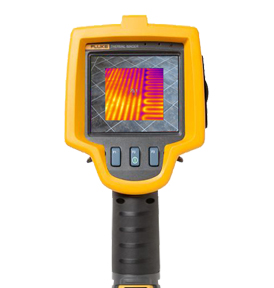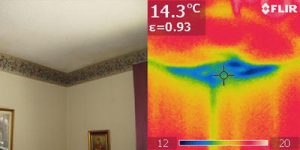Free Thermal Imaging Scan with Every Home Inspection – See What Your Missing
Free Thermal Imaging Scan with every home inspection by the Barrie Home Inspector. This includes all exterior walls  and ceilings of the home. infrared imaging can help you save hundreds, even thousands of dollars per year by detecting moisture, insulation and electrical issues. Thermal Imaging is a non-invasive method of seeing what might be going on behind your walls. The thermal imaging camera picks up very small differences in surface temperature. Thermal Imaging cannot see behind walls but it can detect anomalies due to the emitting qualities of the material.
and ceilings of the home. infrared imaging can help you save hundreds, even thousands of dollars per year by detecting moisture, insulation and electrical issues. Thermal Imaging is a non-invasive method of seeing what might be going on behind your walls. The thermal imaging camera picks up very small differences in surface temperature. Thermal Imaging cannot see behind walls but it can detect anomalies due to the emitting qualities of the material.
Verify Your Systems with Free Thermal Imaging
Thermal imaging can be used to verify your in floor heating or radiant heating in ceilings. In order to function properly there needs to be a temperature difference of a minimum of 20 degrees from outside temperature and the inside temperature. Really cold winter days are ideal for Thermal Cameras as many times the mouse trails in your attic will show up when scanned.
How Does Thermal Imaging Work?
Thermal imaging cameras detect radiation in the infrared range of the electromagnetic spectrum (roughly 9,000-14,000 nanometers or 9-14 m) and produce images of that radiation, called thermograms. Since infrared radiation is emitted by all objects above absolute zero according to the black body radiation law, thermography makes it possible to see one’s environment with or without visible illumination.
Thermal imaging is a non-invasive, non-destructive way of evaluating conditions below the surface. Thermal imaging gives a professional home inspector the ability to see beyond the normally visible. The amount of radiation emitted by an object increases with temperature; therefore, thermography allows one to see variations in temperature. When viewed through a thermal imaging camera, warm objects stand out well against cooler backgrounds.
All materials emit infrared energy differently. Some of them like paint, wood, carpet or plastic emit very well. Others like shiny metals do not. In fact these materials and some other that have smooth surfaces such as glass or ceramic may reflect infrared. A skilled thermographer should know how to deal with these materials, understand the principles of thermodynamics and heat transfer and be able to analyze properly very small temperature variances in the infrared image.
Components Involved in Thermal Imaging Scan
A thermal imaging camera consists of five components: an optic system, detector, amplifier, signal processing, and display. The thermal imaging camera employs a series of mathematical algorithms. Since the camera is only able to see the electromagnetic radiation that is impossible to detect with the human eye, it will build a picture in the viewer and record a visible picture, usually in a JPG format. This picture is included in the report so the client can make an informed decision with all the available information.
During Energy Audits, Infrared Cameras are especially useful when conducting an Infrared Inspection of an attic or hot roof,  “thermal by-passes” are located and can be identified for correction to stop the heat loss. Locating Air Infiltration Points – Along with a “Blower Door” the sources of air infiltration and drafts can be pinpointed. Where cold air comes in, and heat escapes; costing you money! The IR camera helps us identify those locations in association with the blower door. Infrared thermal imaging scans can easily verify insulation inside walls and ceilings. The camera will reveal where there is missing, settled, or wet and damaged insulation. As an added benefit, when we scan your home, we can also identify where cold air is coming through your walls.
“thermal by-passes” are located and can be identified for correction to stop the heat loss. Locating Air Infiltration Points – Along with a “Blower Door” the sources of air infiltration and drafts can be pinpointed. Where cold air comes in, and heat escapes; costing you money! The IR camera helps us identify those locations in association with the blower door. Infrared thermal imaging scans can easily verify insulation inside walls and ceilings. The camera will reveal where there is missing, settled, or wet and damaged insulation. As an added benefit, when we scan your home, we can also identify where cold air is coming through your walls.
Can Thermal Imaging Detect Mould?
Mould, mildew and moisture detection are some of the common tasks that thermal imaging is used for during a home inspection. Where there is moisture, there is “evaporative cooling”. With the use of the IR camera, we can identify areas of moisture and potential breeding grounds for biological growth. Thermography or infrared detection is the leading tool in diagnosing water damage. Whether you are concerned about wasted high energy costs, leaks, smells or quality assurance Thermal Imaging can help identify potential problems.

Recent Comments